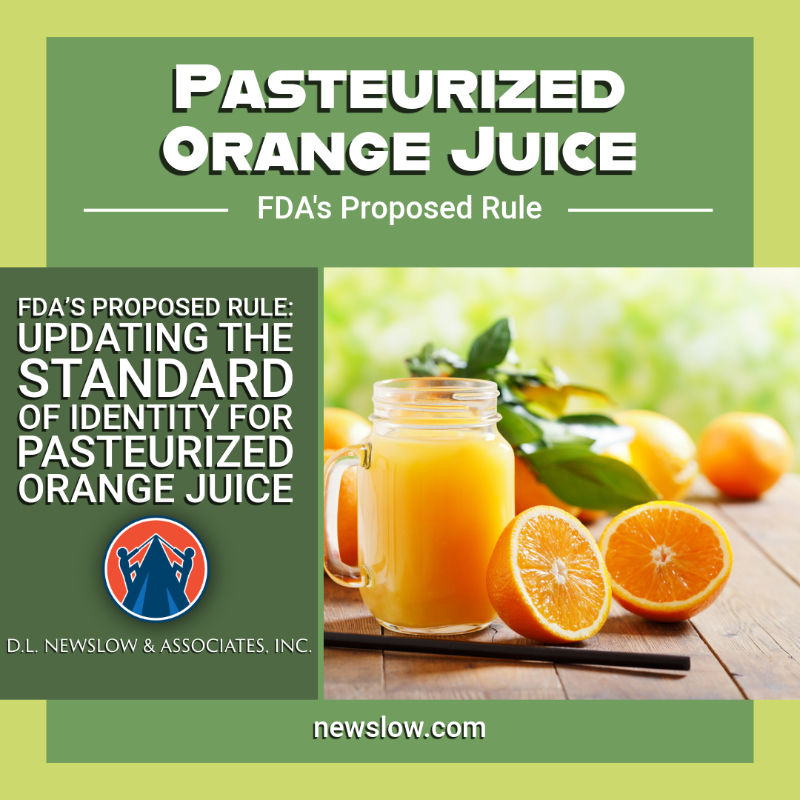FDA’s Proposed Rule: Updating the Standard of Identity for Pasteurized Orange Juice
- M. DuBose

- Aug 8
- 3 min read
On August 5, 2025, the U.S. Food and Drug Administration announced a proposed amendment to the Standard of Identity (SOI) for pasteurized orange juice.

This move, sparked by a citizen petition, aims to modernize a rule that’s over 60 years old to better reflect today’s agricultural realities.
Background: Why Standards of Identity Matter
Standards of Identity define what a consumer expects when they buy a food product. For orange juice, the SOI established in 1963 set requirements for ingredients, manufacturing, labeling, and crucially, a minimum Brix value (a measure of sugar content) of 10.5 percent.
Over time, environmental pressures like severe weather and the bacterial disease citrus greening have driven down the natural Brix level of Florida oranges. To comply with the 10.5 percent threshold, some manufacturers began importing higher-Brix juice from abroad, raising questions about authenticity and fairness in the domestic market.
The Petition: Voices from Florida’s Citrus Industry
In 2022, the Florida Citrus Processors Association and Florida Citrus Mutual filed a citizen petition with the FDA, requesting a reduction in the minimum Brix requirement to 10 percent. Their argument: declining Brix levels make the current standard untenable without relying heavily on imports. By updating the SOI, processors could source more U.S.-grown fruit and avoid supply chain complications.
Proposed Change: What Would Shift?
Current Minimum Brix: 10.5 percent
Proposed Minimum Brix: 10.0 percent
Under the proposal, pasteurized orange juice would still need to meet all existing ingredients, manufacturing, and labeling criteria. The only adjustment is the sugar-content floor, intended to preserve the product’s essential nature while granting producers greater flexibility.
Pros of Lowering the Brix Requirement
Supports domestic growers by reducing reliance on imported juice
Aligns regulatory standards with on-the-ground agricultural realities
Preserves juice authenticity, processors can use more local fruit
Expected to have minimal impact on taste and nutrient profile, per FDA analysis
Streamlines compliance, potentially lowering production costs
Cons and Concerns
Perceived sweetness might decline slightly, affecting consumer preference
Risk of opening loopholes for over-dilution or substitution if oversight lapses
Potential confusion among consumers accustomed to a certain flavor profile
Market disparities: smaller producers may struggle to adjust blending processes
Questions about long-term impacts on nutritional consistency, despite FDA assurances
What’s Next: Your Voice Matters
The FDA is accepting comments for 90 days following the rule’s publication. Industry stakeholders, nutrition experts, and consumers alike can weigh in on whether this tweak strikes the right balance between flexibility and quality. Whether you’re a juice enthusiast, a grower, or simply someone who starts the day with a glass of OJ, now’s the time to share your perspective.
If you’re drafting a formal comment, consider addressing:
Your position on the proposed Brix adjustment
Any data or studies on flavor and nutrient impacts
Implications for domestic sourcing versus imports
Recommendations for monitoring compliance
Let’s ensure the final Standard of Identity both honors consumer expectations and keeps pace with the realities of modern agriculture. Your feedback could shape the future of America’s favorite breakfast beverage.
Additional Considerations
FDA is also seeking comments on:
Whether the minimum Brix level should be lowered further.
Whether the SOI should be eliminated entirely, similar to non-standardized juices like apple juice.
Whether the maximum percentage of citrus reticulata (mandarin hybrids) allowed in orange juice should be increased from 10% to 15%, due to their higher sugar content.
Publication and Comment Period
The proposed rule was officially published in the Federal Register on August 6, 2025.
The public comment period is open until November 4, 2025, allowing stakeholders to submit feedback via Regulations.gov.




Comments